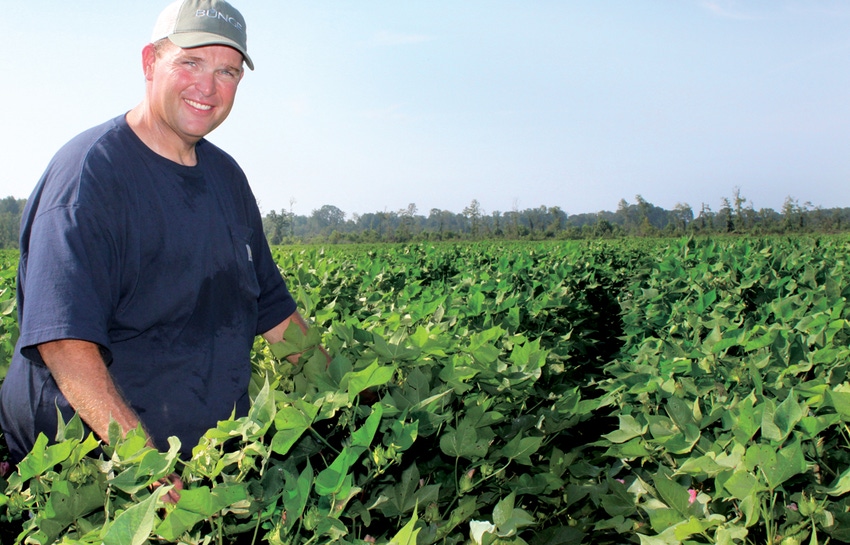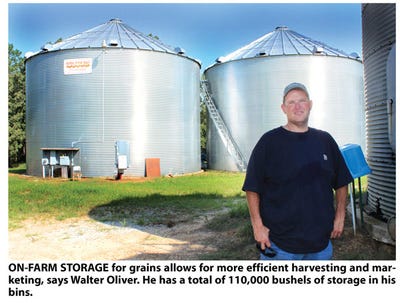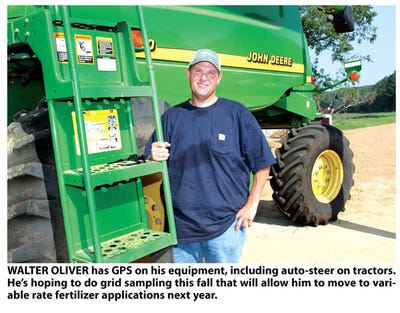
Walter Oliver: ‘Once you’ve grown cotton, it’s hard to get away from it’
"I grew up in a cotton-oriented environment," says Walter Oliver, who farms in north central Mississippi, "and though I’ve grown soybeans and corn, cotton is my favorite. There’s just something about cotton — once you’ve grown it, it’s hard to get away from it." He favors a cotton/corn rotation, and this year has 1,500 acres of cotton and 1,350 acres of corn.

At 9:00 on this August morning, the sun is already scorching, the forecast heat index for the day is 115 or better, and Walter Oliver is getting ready to spray two of his larger cotton fields for plant bugs, along with a second application of Pix.
“It was wet when I planted here and I got a little behind,” he says. “Everything else has already had two or three applications of Pix. Otherwise, the plants would probably be head-high.
“The cotton’s looking really good at this point. We got a nice Fourth of July rain and the last week in July we got almost 7 inches over much of the area. Unfortunately, it was too late to do much good for some of the corn. Some of it’s pretty burned up, but across the board it’s in pretty good shape. I’ll probably start combining toward the end of August.”
Oliver, who farms in Carroll and Montgomery Counties in north central Mississippi, has an operation that encompasses 100 or so fields, stretching 10 miles north-south and 15 miles east-west. The largest fields are 175 acres and 140 acres and the others range all the way down to less than 10 acres.
“It takes a lot of equipment moving,” he says, “but I’ve got a system for it and it works pretty well.”
The farms include his father’s home place, where Walter grew up, but most of the land he farms is rented.
“Dad [Bobby Oliver] and I farmed about 50-50 until he retired, and this is my third year farming on my own. He had always grown cotton, as did my grandfather, Sandy Land, who also had a cotton gin. I grew up in a cotton-oriented environment and, though I’ve grown soybeans and corn, cotton is my favorite. There’s just something about cotton — once you’ve grown it, it’s hard to get away from it.
Dropped out of cotton
“For three years, when the cotton price dropped so much and grain prices were coming on strong, we were out of cotton. The economics were so much better for beans and corn, and yields were good for both — 50 bushels plus for soybeans and 145 to 150 bushels for corn, both dryland.
“Even though we hadn’t been growing grains, we had been doing custom combining for other people, so we already had the equipment and the switch to grains was easier for us than for those who’d been all cotton.”
Like many growers, he took a major hit with soybeans in rain-plagued 2009.
“I managed to cut about 100 acres of beans before the fall rains set in, and was getting 60 bushels plus. When I finally got back in to cut the rest, they averaged 15 bushels and I had to haul them all to salvage. That kind of situation really hurts.”
Oliver says his present rotational program of cotton and corn works particularly well, and with the strong price outlook for cotton this year, he felt costs vs. returns were better than for soybeans.
This year, he has 1,500 acres of cotton and 1,350 acres of corn. The sandy loam soils, mostly bottomland fields along Hayes Creek, are consistently productive, given that he can’t irrigate.
“Cotton this year is predominantly Stoneville 5458 and 0912, but I have about 100 acres of Deltapine 1137, some Deltapine 0912, and some Stoneville 4288,” Oliver says. “All are Roundup Ready, Flex, Bt varieties.
“Last year was my first year back in cotton and the 5458 and 0912 varieties performed really well. I had 500 acres and averaged better than 1,200 pounds, which is good for dryland cotton here in the hills.”
“Last year, I sold about 300 bales at 72 cents and then started selling again at 90 cents. On some cotton that I didn’t have booked, I got $1 or better — something I never thought I’d see. This year, I’ve got a bale per acre booked at $1.10 to $1.15 and I’m hoping to have another bale or so to sell over and above that.”
Cotton on stale seedbed
Cotton goes on a stale seedbed that has been rowed up in the fall; in the spring, he makes a burndown application, runs a Do-all, and plants.
This year’s crop was planted May 5-16. “I applied three shots of Roundup, and laid by with Roundup and Valor, which pretty much takes care of weed control for the season. I used to apply only two shots of Roundup, but when the price came down, I added a third for better control.”
For insects thus far this year, Oliver sprayed Bidrin early for thrips and has applied Bidrin and Centric for plant bugs.
He expects to start harvesting the last of September or first of October.
His consultant, Heath Hill at Jimmy Sanders, Greenwood, Miss., works with him on crop management and treatment recommendations. He gins his cotton at Vaiden Gin, Vaiden, Miss., and markets it through Chassaniol Cotton at Greenwood, Miss.
Corn has worked out well in his cropping program, he says, although the hot, dry June this year and last year took a toll on the crop.
“I’m hoping to average about the same as last year, 145 to 150 bushels, although some spots will do better,” he says.
He plants several varieties of corn, but the largest acreages are DeKalb 6805, followed by Pioneer 1615.
“Corn is planted either stale seedbed or no-till; behind cotton, I prefer to plant no-till. After burndown, I apply Halex and atrazine and that pretty much takes care of weed control till harvest, which usually starts about the end of August.”
He takes soil samples every year and follows laboratory recommendations for fertility.
“I’ll use a 20-50-90 mix on cotton ground and sidedress with N-SOL. For corn, I apply 70-70-70 up front and sidedress with N-SOL.
Variable rate fertilization
“With the high prices of fertilizer, I looked into poultry litter. But there’s a lot of time and work in hauling and spreading it, and the economics just didn’t work for me. This fall, I’m going to start grid sampling so I can go to variable rate fertilizer applications, which I hope will help hold down the cost. I used variable rate on corn for the first time this year.”
“I’ve got GPS and auto-steer on my tractors, swath control on the sprayer, and a yield monitor on the combine. If I do variable rate on cotton next year, I’ll also add a yield monitor to the picker.”
His equipment lineup is John Deere, and includes three 8000 series tractors, 12-row planters on 38-inch spacing, a 9650 combine, a 9986 6-row cotton picker, and a 4710 sprayer.
As is the case with farmers over much of Mississippi, an increasingly troublesome “pest” is deer. “They haven’t bothered cotton and corn much this year, but last year they ate 20 or so acres of soybeans clear to the ground.” He’s also got a large patch of hybrid pumpkins (“$50 a pound for the seed”) that he grows for area school kids, and he’s hoping the deer won’t bother them.
Oliver has three full-time employees, and his father helps out at planting, harvesting, and other busy times. A cousin also lends a hand when needed. Most of the equipment servicing and maintenance is done in his farm shop.
He has 110,000 bushels of on-farm storage. “It really helps smooth out things at harvest, when we’ve got grain coming out of the field fast and furious, and it allows me to market more efficiently.” He sells his grain through Bungee at Yazoo City, Miss.
He has also used grain bags for short term, in-the-field storage. “That has worked well,” he says. “I’ll put 10,000 or so bushels in a bag.”
Having grown up on a farm, Oliver says, “Farming is something I pretty much always knew I wanted to do — and [he laughs] when I was old enough that it dawned on me I couldn’t be a football player forever [he played on high school and community college teams], I came back and farmed with my father. It’s a great life, and I can’t imagine doing anything else.
“As land became available, we steadily got larger. I’d like to keep growing, but land doesn’t become available very often in this area.”
Oliver and his wife, Christy, have three children: Rhett, 10; Reece, 8; and Lucy Grace, almost 5.
About the Author(s)
You May Also Like



